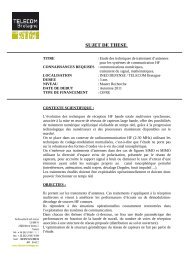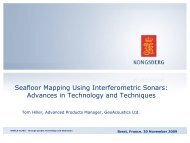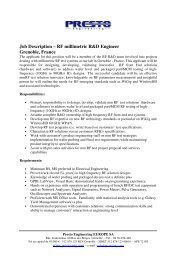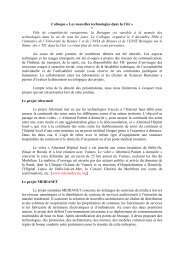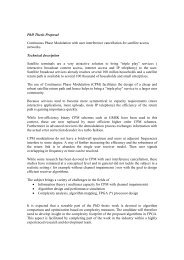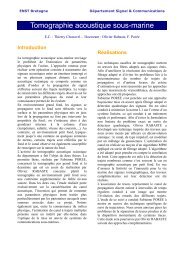Département Réseau, Sécurité et Multimédia Rapport d'Activités 2008
Département Réseau, Sécurité et Multimédia Rapport d'Activités 2008
Département Réseau, Sécurité et Multimédia Rapport d'Activités 2008
Create successful ePaper yourself
Turn your PDF publications into a flip-book with our unique Google optimized e-Paper software.
Management of Multiple Access N<strong>et</strong>worksN<strong>et</strong>work centric QoS management in an operatorh<strong>et</strong>erogeneous mobile n<strong>et</strong>workResearch Staff : Jean-Marie Bonnin – Ph.D. student: Anis ZouariKeywords : h<strong>et</strong>erogeneous access n<strong>et</strong>works, QoS, vertical handover, seamless mobilityApplications : mobile operator n<strong>et</strong>worksPartners & Funding : CIFRE France Telecom R&DIntroductionIn the current-generation wireless communicationsystems, users have a large choiceof the access technology for their Intern<strong>et</strong>connections: cellular n<strong>et</strong>works, as theUniversal Mobile Telecommunications System(UMTS), wireless local n<strong>et</strong>works, as thewireless local area n<strong>et</strong>works (WLAN) or WorldInteroperability for Microwave Access(WiMAX). As a result, many research activitiesare investigating the issues of using mobil<strong>et</strong>erminals which may have multiple wirelesscards in current n<strong>et</strong>works. However, deliveringadvanced services, preferably seamlessly andin the "best" manner, over these variousaccess technologies requires both enhancedn<strong>et</strong>works decision and execution capabilities aswell as much more functionalities in the endterminals.RealizationA functional definition of the QoS and mobilitymechanisms to be specified has been issued.This step leverages on a survey of various QoSmanagement approaches such as the onesproposed in DAIDALOS [1] and AmbientN<strong>et</strong>work [2] European projects. Then, thecompl<strong>et</strong>e specifications of the mechanismspreviously defined have been designed.In the new proposed architecture, thehandover decisions are distributed dynamicallyb<strong>et</strong>ween several entities according to the loadconditions of the n<strong>et</strong>work and therequirements of the applications and the users.We specified a solution compatible with theexperimental models developed at Orange-Lab: the proposed QoS mechanisms is to beintegrated into the mobility managementmodel called Hierarchical and DistributedHandover management [3].Then we integrated the QoS mechanisms intothe hierarchical and distributed architecturedesigned in the first phase of this work: thesemechanisms are distributed throughout thedifferent entities of the proposed architecture.The QoS and mobility managementmechanisms have been enhanced by thefollowing functional processes:1) Algorithm used to decide which handovertype should be performed: Indeed theproposed architecture supports multiple typesof handover execution such as Make-beforebreakhandover, Break-before-make handover,Anticipated handover and Unanticipatedhandover. In this case, the handover to beperformed will be chosen according to theapplication and client type, this, in order tosatisfying the requirements of any applications.2) QoS data transfer (such as QoSparam<strong>et</strong>ers): QoS data needed during ahandover will be divided into several partsaccording to the current informationlocalization. For example, param<strong>et</strong>ers relatedto the core n<strong>et</strong>work, param<strong>et</strong>ers related to theIP access n<strong>et</strong>work (transmission delay),param<strong>et</strong>ers related to the radio access n<strong>et</strong>work(bandwidth) and param<strong>et</strong>ers related to thepoint of attachment (class of service). In orderto improve the performance of the mechanismfor transferring QoS data, some informationcan be broadcast either to a list of IP accessn<strong>et</strong>work manager or a list of radio accessmanager or a list of candidate point ofattachment.3) Proactive distributed negotiation: QoSparam<strong>et</strong>ers will be shared b<strong>et</strong>ween severallevels. At each level, the negotiation process isperformed for the param<strong>et</strong>ers associated tothis level. In addition, a controlled or assistedn<strong>et</strong>work negotiation is integrated into thisarchitecture.We compared the negociation processdesigned in the new architecture to the oneapplied in UMTS Release 5 [4]. And the results22 Extract of Pracom’s Annual Report <strong>2008</strong>




